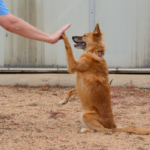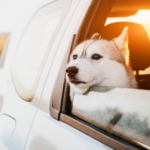Introduction
Nose work, or dog scent detection games, offers more than just entertainment for dogs. It taps into their natural instinct to explore and use their sense of smell, providing mental stimulation, physical exercise, and an opportunity to strengthen the bond between dogs and their owners. This article delves into the fascinating world of canine nose work, exploring its benefits and offering practical tips for getting started.
Understanding Canine Nose Work
Canine nose work is a fascinating activity that taps into a dog’s incredible sense of smell, offering both mental stimulation and a rewarding bonding experience for dogs and their owners. At its core, nose work harnesses the remarkable olfactory abilities of dogs, which are known to be far superior to humans. The science behind a dog’s sense of smell is truly remarkable; they possess up to 300 million olfactory receptors in their noses, compared to just 6 million in humans, enabling them to detect scents with incredible precision and sensitivity. This heightened sense of smell is a result of evolution, as dogs have relied on their olfactory abilities for survival throughout history.
The origins of nose work can be traced back to scent detection training for working dogs, particularly in law enforcement and search and rescue operations. Dogs have been used for centuries to track and locate scents, whether it’s finding missing persons, detecting drugs or explosives, or locating contraband. Nose work as a recreational activity for pet dogs originated from these practical applications, with enthusiasts adapting scent detection training techniques into fun and engaging games for dogs to enjoy.
Understanding the foundations of canine nose work allows dog owners to appreciate the natural abilities of their furry companions and provides insight into why nose work is such a fulfilling activity for dogs. By delving into the science behind a dog’s sense of smell and exploring the historical context of nose work, owners can gain a deeper understanding of how this activity benefits their dogs both mentally and physically. Whether it’s a simple game of hide-and-seek with treats or more advanced scent detection challenges, engaging in nose work with your dog is a rewarding experience that strengthens the bond between human and canine.
Benefits of Nose Work for Dogs
Nose work, often dubbed as “scent work” or “scent detection,” isn’t just a fun game for dogs—it’s a mentally enriching activity that offers a myriad of benefits for canines of all ages and breeds. One of the primary advantages of nose work is the mental stimulation it provides. Dogs have an exceptional sense of smell, and engaging in nose work tasks allows them to exercise this natural ability in a challenging and rewarding way. By using their noses to locate specific scents or objects, dogs engage in a stimulating mental exercise that keeps their minds sharp and focused.
Beyond mental stimulation, nose work can also help alleviate boredom in dogs. Many behavioral issues in dogs stem from boredom and lack of mental stimulation, leading to destructive behaviors like chewing or excessive barking. By introducing nose work activities into their routine, dog owners can provide their furry companions with a constructive outlet for their energy and curiosity, reducing the likelihood of boredom-related behavior problems.
Moreover, nose work has been found to have a calming effect on anxious or nervous dogs. The focused nature of scent detection tasks can help dogs relax and unwind, redirecting their attention away from stressful stimuli and promoting a sense of calmness. For dogs prone to anxiety or fearfulness, engaging in nose work activities can provide a valuable tool for managing their emotions and building confidence.
Getting Started with Nose Work
Embarking on the journey of nose work with your dog is an exciting adventure that promises mental stimulation, enrichment, and bonding opportunities. Getting started with nose work doesn’t require any specialized equipment or training—it’s all about tapping into your dog’s natural instincts and providing the right environment for exploration and discovery.
To begin, start with simple nose work exercises that introduce your dog to the concept of using their sense of smell to locate hidden treats or toys. You can start by hiding treats in plain sight and encouraging your dog to find them using verbal cues or gestures. Gradually increase the difficulty by hiding treats in more challenging locations, such as behind furniture or under objects.
Creating a conducive environment for nose work activities is essential for your dog’s success and enjoyment. Choose a quiet and familiar space where your dog feels comfortable and relaxed, such as a living room or backyard. Minimize distractions that could interfere with your dog’s focus, such as loud noises or other pets.
Consider investing in nose work supplies like scent boxes or odor containers to enhance your dog’s training experience. These tools allow you to introduce specific scents for your dog to search for, adding an extra layer of challenge and complexity to their nose work exercises.
Remember to be patient and encouraging as you introduce your dog to nose work. Every dog learns at their own pace, so it’s essential to celebrate their progress and offer plenty of praise and rewards along the way. With consistency and positive reinforcement, you and your dog will soon be well on your way to mastering the art of nose work together.
Overcoming Challenges
Embarking on the journey of nose work with your dog can be incredibly rewarding, but like any training endeavor, it comes with its fair share of challenges. From distractions to lack of motivation, overcoming these obstacles is key to ensuring a successful and enjoyable nose work experience for both you and your furry friend.
One common challenge in nose work training is dealing with distractions that can derail your dog’s focus and attention. Whether it’s the presence of other pets, outdoor noises, or interesting scents, distractions can make it difficult for your dog to concentrate on the task at hand. To overcome this challenge, start by gradually increasing the level of distraction during training sessions. Begin in a quiet, controlled environment and slowly introduce distractions as your dog becomes more proficient in nose work. Use high-value treats or toys to keep your dog engaged and motivated despite distractions.
Another challenge you may encounter is a lack of motivation from your dog, especially if they are not naturally inclined to use their sense of smell or if they are feeling tired or unwell. In such cases, it’s essential to find ways to make nose work activities more enjoyable and rewarding for your dog. Experiment with different types of treats or toys to find what motivates your dog the most, and consider incorporating play breaks or short training sessions to keep their energy levels up.
Difficulty in finding suitable training aids can also pose a challenge, especially if you’re limited by space or resources. Fortunately, there are plenty of DIY options available, such as using cardboard boxes or household items to create hiding spots for treats or scents. Additionally, you can invest in commercially available nose work kits or training aids designed specifically for this purpose.
Taking Nose Work to the Next Level
As you and your furry companion become more adept at nose work, you may find yourselves ready to take your skills to the next level. Advanced nose work techniques and games offer exciting challenges that can further stimulate your dog’s keen sense of smell while providing enriching mental and physical exercise.
One advanced nose work technique to explore is container searches, where your dog is tasked with identifying the scent of a target object hidden among a group of containers. This game not only hones your dog’s scent detection abilities but also requires them to use their problem-solving skills to locate the target.
Another thrilling challenge is exterior searches, where your dog must search for hidden scents in outdoor environments such as parks, fields, or urban landscapes. The vast array of smells and distractions present in outdoor settings add an extra layer of difficulty to the game, making it an exhilarating experience for both you and your dog.
For the ultimate test of your dog’s scent detection prowess, consider introducing vehicle searches. In this game, your dog must search vehicles for hidden scents, simulating real-life scenarios where working dogs are deployed to detect contraband or search for missing persons. Vehicle searches require a high level of focus and precision from your dog, making them an excellent way to challenge and strengthen their scent detection abilities.
To further enhance your nose work journey, consider participating in nose work competitions or enrolling in nose work classes. Competitions provide an opportunity for friendly competition and camaraderie among fellow nose work enthusiasts, while classes offer structured guidance and expert instruction to help you and your dog refine your skills.
Conclusion
By understanding the fundamentals of nose work and incorporating it into your dog’s routine, you can unleash their potential and enhance their overall quality of life. Incorporating nose work into your dog’s routine can provide numerous benefits, from mental stimulation to strengthening your bond. Start exploring the world of scent detection games today and watch as your dog’s natural abilities shine!







